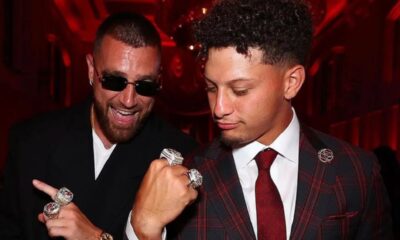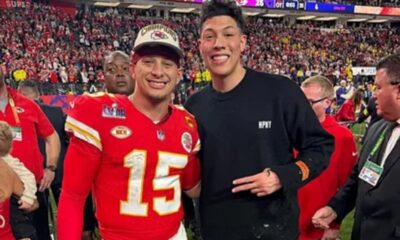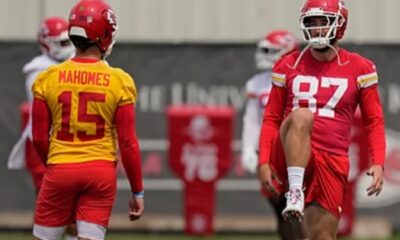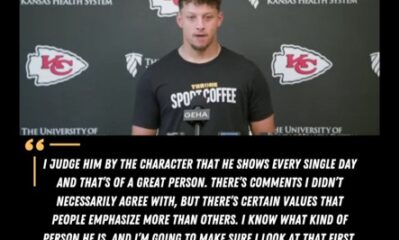NEWS
Patrick Mahomes is influencing the NFL Draft narrative for all the wrong reasons
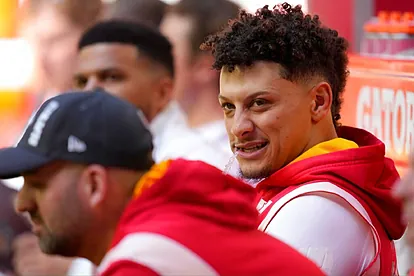
Seven years ago Saturday, NFL commissioner Roger Goodell stood in front of a crowd outside a Philadelphia art museum and read a name from a notecard.
A city some 1,100 miles away would never be the same.
The Chiefs’ draft pick that day, the quarterback from Texas Tech that nine other teams had passed over, forever changed the trajectory of their franchise.
But being the team that was right about Patrick Mahomes was only half the work.
The Chiefs first had to give themselves a chance to land Patrick Mahomes — and they had to give Patrick Mahomes a chance to be good at this, too.
In the end, the former required a first-round pick swap with the Bills, climbing 17 spots to No. 10 overall, and then sweetening the pot with a third-rounder and a first-round pick from the following season.
A bargain, right?
Well, it doesn’t always turn out that way. It doesn’t even usually turn out that way.
That just might be relevant this week. The 2024 NFL Draft is here, and with it comes a deep quarterback class, even beyond the Chicago-bound Caleb Williams. At least four quarterbacks will be selected in the first round, and possibly as many as six.
But let’s talk another possibility.
The trade-up.
The Vikings, Giants and maybe an AFC West team or two could be among those considering a move to get their franchise quarterback. The price will be steep. The Vikings, for example, could have to part with Nos. 11 and 23 overall this year and a first-rounder next season just to acquire No. 3 overall.
Many times over, I’ve heard the Mahomes example used as justification for giving up such a haul for a quarterback. You’d relinquish even more for Mahomes, in retrospect, after all.
One problem: It’s flat-out the wrong way to apply the example.
Over the last 15 years, here’s a list of quarterbacks selected after teams swung first-round trades to select them, in chronological order: Tim Tebow, Blaine Gabbert, Robert Griffin III, Teddy Bridgewater, Johnny Manziel, Jared Goff, Carson Wentz, Paxton Lynch, Patrick Mahomes, Mitchell Trubisky, Deshaun Watson, Sam Darnold, Josh Allen, Josh Rosen, Lamar Jackson, Jordan Love, Trey Lance, Justin Fields and Bryce Young.
It’s not exactly a snapshot of the elite class. Only five of those 19 players are still with the team that drafted them.
Mahomes has more playoff wins (15) than the rest of the 18 quarterbacks combined (14).
But let me be abundantly clear about the intent behind sharing that statistic. It is not to fully blame the quarterback and only the quarterback for the lack of playoff success. It’s instead setting up the second part of the point.
While all of the conversation narrows on which quarterback certain teams should target, we focus far too little on a different question:
Which situation?
The quarterback — even the right quarterback — does not equal a get-out-of-jail-free card for everything else. It is the most important position in sports to be sure, and by a wide margin, but you cannot just ignore the margins.
Those who have solved the situation component before making the draft-day move — those who took care of the margins — correlate to a path of success far more than which quarterback was the subject of the trade itself.
It’s a small sample size over the last 15 years, because these kinds of trades will never come in large enough quantities, but let’s trace back to that list of quarterbacks for the evidence.
Seven of the 19 quarterbacks acquired via a trade up in the first-round in the last 15 years have won a playoff game: Mahomes (15 playoff wins), Allen (5), Goff (4), Jackson (2), Love (1), Watson (1) and Tebow (1). The other 12 quarterbacks have never won a playoff game.
• Among the seven to win in the playoffs, five were drafted by teams that were coming off a winning season.
• Among the 12 yet to win a playoff game, only one was drafted by a team that was coming off a winning season.
The situation mattered at least some.
Yet the blame for the good and the bad? The quarterback.
Isn’t that too simple? Using that same 15-year time frame, you can spit out the numbers a different, but similarly telling, way. (And I hope it doesn’t prompt confusion):
• Among the six quarterbacks lucky enough to join winning programs, five are still starters in the league today. That’s 83.3% of them.
• Among the 13 who joined losing programs, only two are starting today: Jared Goff and Bryce Young, who went 2-14 as a rookie last year. That’s 15.4% of them.
You could argue we’re in an unusual period of time, but, either way, the data is pretty compelling within that period.
There is so much emphasis on the quarterback, and rightfully so in many respects, but the analysis of their rookie contract success omits key information: What kind of team drafted them?
That’s the part the Chiefs nailed.
And the quarterback.
It is not one or the other. It is both. The quarterback matters more than everything else. But the everything else plays a pretty significant factor, too.
It sure helped that the Chiefs had the head coach and a talented roster, including the top tight end in the league, before they drafted Mahomes. They had a roster that could afford to go without a first-round pick the following year, as opposed to a franchise that pushed all of its assets into the quarterback, still with gaping roster holes on the back end.
That is the lesson in the Mahomes first-round trade.
It is not to acquire a quarterback at all costs. It is to prepare your roster to do so, and then make the move.
The teams best equipped to make a trade up in the draft are not those extra convinced about the player. They don’t have the secret. It’s still a hit-and-miss proposition. The teams best equipped to make the move are those who consider the quarterback closer to the last piece of the puzzle than the first.
Just look at the team in KC.

